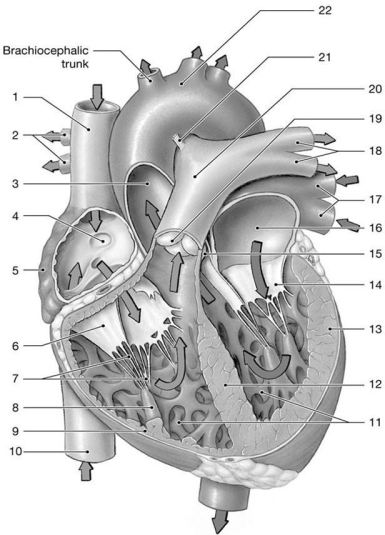A) 1,000
B) 10,000
C) 100,000
D) 1,000,000
E) 10,000,000
G) B) and C)
Correct Answer

verified
Correct Answer
verified
Multiple Choice
Figure 20-1 The Heart
 Use Figure 20-1 to answer the following questions:
-Identify the structure(s) labeled "8."
Use Figure 20-1 to answer the following questions:
-Identify the structure(s) labeled "8."
A) moderator band
B) pectinate muscles
C) papillary muscles
D) trabeculae carneae
E) chordae tendineae
G) B) and E)
Correct Answer

verified
Correct Answer
verified
Multiple Choice
The right ventricle pumps blood to the
A) right and left lungs.
B) left ventricle.
C) left atrium.
D) aorta.
E) right atrium.
G) C) and E)
Correct Answer

verified
Correct Answer
verified
Multiple Choice
Blood returning to the heart from the systemic circuit first enters the
A) right atrium.
B) right ventricle.
C) left atrium.
D) left ventricle.
E) conus arteriosus.
G) A) and C)
Correct Answer

verified
Correct Answer
verified
Multiple Choice
In a procedure known as ________, an inflatable balloon at the end of a catheter is used to press plaqueback against the vessel wall.
A) balloon angioplasty
B) coronary arterial bypass graft
C) intravenous catheterization
D) ablation
E) atherectomy
G) A) and B)
Correct Answer

verified
Correct Answer
verified
Multiple Choice
During ventricular systole, the
A) atria are contracting.
B) blood is entering the ventricles.
C) AV valves are closed.
D) pressure in the ventricles remains constant.
E) pressure in the aorta remains constant.
G) None of the above
Correct Answer

verified
Correct Answer
verified
Multiple Choice
The backward flow of blood from a ventricle to its atrium or from a outflow vessel to its ventricle iscalled
A) emesis.
B) flutter.
C) fibrillation.
D) regurgitation.
E) stenosis.
G) A) and E)
Correct Answer

verified
Correct Answer
verified
Multiple Choice
The ________ carry blood toward the heart.
A) arterioles
B) arteries
C) veins
D) lacteals
E) capillaries
G) None of the above
Correct Answer

verified
Correct Answer
verified
Multiple Choice
Which valve(s) cusps open up toward the base of the heart?
A) right and left AV valves
B) aortic and pulmonary valves
C) left AV and aortic valves
D) right AV and pulmonary valves
E) right AV, left AV, aortic and pulmonary valves
G) A) and E)
Correct Answer

verified
Correct Answer
verified
Multiple Choice
The amount of blood remaining in the ventricle when the semilunar valve closes is the
A) ejection fraction.
B) end-diastole volume.
C) start-diastolic volume.
D) end-systolic volume.
E) stroke volume.
G) B) and D)
Correct Answer

verified
Correct Answer
verified
Multiple Choice
The right pulmonary veins carry ________ blood to the ________.
A) deoxygenated; left atrium
B) oxygenated; right lung
C) deoxygenated; superior vena cava
D) deoxygenated; right atrium
E) oxygenated; left atrium
G) B) and D)
Correct Answer

verified
Correct Answer
verified
Multiple Choice
Considering the left ventricle, why does isovolumetric ventricular contraction occur during ventricularsystole?
A) The ventricle needs to pressurize the blood to close the aortic valve.
B) Ventricular pressure is greater than atrial pressure so the ventricle cannot eject blood.
C) The bicuspid valve needs time to shut before the ventricle can eject blood.
D) Aortic pressure is higher than ventricular pressure and the ventricle must pressurize the blood to open the aortic valve.
E) The ventricle is still filling with blood and therefore cannot eject blood during this time.
G) B) and E)
Correct Answer

verified
Correct Answer
verified
Multiple Choice
Each of the following factors will increase cardiac output except increased
A) venous return.
B) parasympathetic stimulation.
C) sympathetic stimulation.
D) heart rate.
E) force of contraction.
G) B) and C)
Correct Answer

verified
Correct Answer
verified
Multiple Choice
Depolarization of the ventricles is represented on an electrocardiogram by the
A) P wave.
B) T wave.
C) S wave.
D) QRS complex.
E) PR complex.
G) A) and B)
Correct Answer

verified
Correct Answer
verified
Multiple Choice
________ is when the heart can't maintain adequate cardiac output.
A) Heart failure
B) Fibrillation
C) Flutter
D) Murmur
E) Coronary heart disease
G) B) and C)
Correct Answer

verified
Correct Answer
verified
Essay
If a patient's resting cardiac output is 5.6 l/min and on a stress test she elevated her heart rate to amaximum of 176 beats/min with a stroke volume of 115 ml/beat, what is her cardiac reserve? Show your work.
Correct Answer

verified
Cardiac reserve equals maximum...View Answer
Show Answer
Correct Answer
verified
View Answer
Multiple Choice
The amount of blood returning to the heart is the
A) afterload.
B) stroke volume.
C) end-diastolic volume.
D) cardiac reserve.
E) venous return.
G) A) and E)
Correct Answer

verified
Correct Answer
verified
Multiple Choice
The ________ lines the chambers of the heart, covers the heart valves, and is continuous with the endothelium.
A) epicardium
B) myocardium
C) endocardium
D) visceral pericardium
E) mediastinum
G) A) and D)
Correct Answer

verified
Correct Answer
verified
Showing 161 - 178 of 178
Related Exams